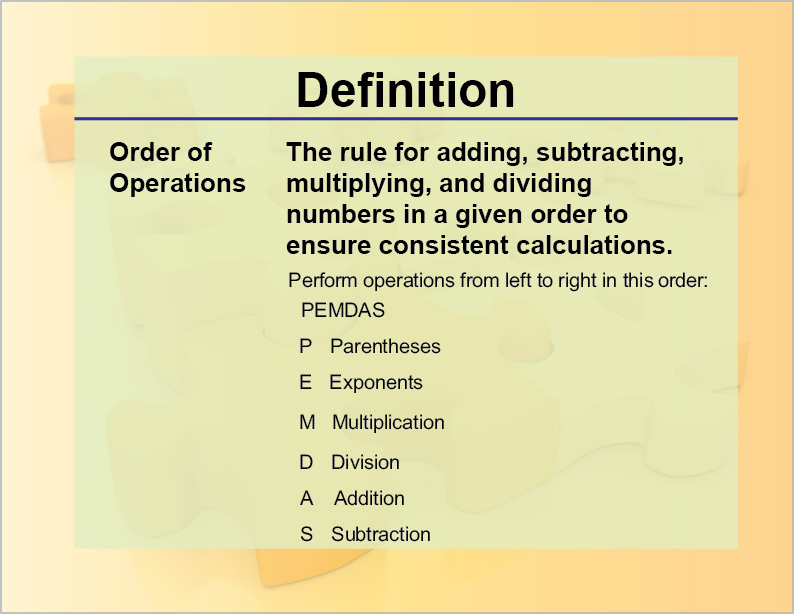
Display Title
Definition--Order of Operations
Display Title
Definition--Order of Operations
Watch the following video on Order of Operations. (The transcript is included.)
Video Transcript
A numerical expression includes numbers and operation symbols, addition, subtraction, multiplication, and division.
Because addition is commutative, adding from left to right, or right to left, gives you the same result.
The expressions 2 + 3 and 3 + 2 give the same result. But this isn't the case with all operations.
Subtraction isn't commutative.
4 - 2 is not the same as 2 - 4.
The order of operations is a rule, or convention, that ensures the same result is obtained for any numerical expression.
The first rule is to operate on numbers from left to right.
This expression is read from left to right as "five plus three," not "three plus five."
All expressions are always read from left to right.
The next rule is that any expressions in parentheses are simplified first.
Look at this expression: The quantity two plus three times the quantity six minus four.
Simplify the expressions in parentheses first. The result is five times two.
The result is 10.
The next rule is that any expressions with exponents are simplified (after simplifying expressions in parentheses).
Look at this expression: The quantity two plus five, squared, plus 10.
First, simplify the term in parentheses first.
The result is seven squared + 10. Simplify the squared term first.
The result is 49 plus 10, which is 59.
The next rule is that after parentheses and exponents, then perform multiplication and division.
Look at this expression: The quantity two plus four, squared, times the quantity four plus six, divided by 2.
Start with the terms in parentheses, which results in 6-squared times ten divided by two.
Next do exponents, which results in thirty-six times ten divided by two.
The result is three hundred sixty divided by two, which simplifies to one hundred eighty.
The final rule is that after parentheses, exponents, multiplication and division, perform addition and subtraction.
Look at this expression: The quantity thirteen minus three, cubed divided by two, minus the quantity five plus three, squared, times two, plus five.
Start with the terms in parentheses, which results in: ten cubed divided by two minus the quantity eight squared times two, plus five.
Next, simplify the exponential terms, which results in one thousand divided by two minus the quantity sixty-four times two, plus five.
Next, perform the multiplication and division, which results in five hundred minus one hundred twenty eight plus five.
The last step is addition and subtraction. The result is 377.
The order of operations is summarized by the acronym PEMDAS, which stands for
Parentheses
Exponents
Multiplication
Division
Addition
Subtraction
Called PEMDAS, the order of operations ensures that for any numerical expression, the same results will be obtained.
This is part of a collection of images that cover key vocabulary on a variety of math topics.
Note: The download is a PNG file.
Related Resources
To see additional resources on this topic, click on the Related Resources tab.
Create a Slide Show
Subscribers can use Slide Show Creator to create a slide show from the complete collection of math definitions on this topic. To see the complete collection of definitions, click on this Link.
To learn more about Slide Show Creator, click on this Link.
Accessibility
This resources can also be used with a screen reader. Follow these steps.
-
Click on the Accessibility icon on the upper-right part of the screen.

-
From the menu, click on the Screen Reader button. Then close the Accessibility menu.

-
Click on the PREVIEW button on the left and then click on the definition card. The Screen Reader will read the definition.
| Common Core Standards | CCSS.MATH.CONTENT.6.EE.B.7, CCSS.MATH.CONTENT.8.EE.C.7 |
|---|---|
| Grade Range | 6 - 12 |
| Curriculum Nodes |
Algebra • The Language of Math • Numerical Expressions • Variable Expressions |
| Copyright Year | 2013 |
| Keywords | order of operations, PEMDAS, definitions, glossary term |